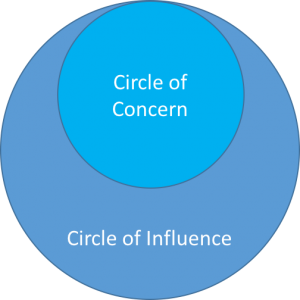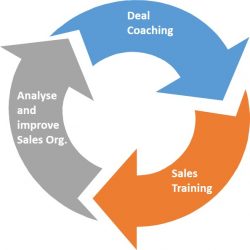The Picture of the Circle of Influence and the Circle of Concern are quite popular – for a good description see Stephen Covey or at Wikipedia.
Basically, the concept says that everyone is operating in two circles – the circle of concern, and the circle of influence. In case the circle of influence is larger than the circle of control, one has overall control of a situation. This is because all concerns are within the circle of influence. In case the circle of concern is larger than the circle of influence, one is not in control of a situation, because not all concerns can be addressed:

A proactive behaviour is, whenever the circle of influence is expanding, and encompassing the circle of concern.
This entry looks at the concept with regards to Outsourcing Deals – so how to become proactive?
First of all, being proactive in deals is mainly about NOT waiting for a RFP to turn up, but to create opportunities and proactively shape them. Obviously, being the one person or team able to talk to a prospective customer and creating an opportunity gives you an advantage. It will enable you to shape this opportunity into a deal that is tailored to your strength and offering portfolio. This will also, if done properly, lead to an ever increasing circle of influence. If you can expand the circle of concern, it means that the scope of the deal can be increased, leading to an overall larger deal. This results in potentially less competition because with the size, usually also the deal complexity increases.
So how does this circle of influence work – well, most of this is of course Customer Relationship, basically listening to the customer and really understanding his concerns – not only the ones stated, but the underlying deeper problems that the customer might not be aware of.
Further, during later stages of the deal, the expanded circle of influence can be used to stay ahead of the competition by addressing the circle of concern that the customer has, and keep it if possible within the circle of influence of the team.
Influencing scope and shape of a deal
One key tactic is to shape the deal in way that you are able to address the customer’s circle of concern with your circle of influence. Wherever you are not able to address a customer’s concern, you need to think of how to descope areas that you can’t address. This is also closely related to “A Simple Competitive Analysis” where I describe how to position a deal and it’s scope in a competitive environment so that it highlights my own USP’s and hides my weak areas. Here, the approach is much the same: Customer concern that I cannot address, should be moved out of scope, or moved in the perception of the customer into something that is not important, and therefore not a concern anymore.
Simple analysis of Circle sizes
If Concerns are much larger than Influences, you will not be able to win the deal, because in the view of the customer, you will be able to address only a part of the problem, and not deliver a full solution.
If the circle of concern is the same size than the circle of influence, the customer will see that you are able to deliver, but it will take you all your energy and resources to do so. This can be good for a customer (they know that you will treat them like a truly strategic partner), but it also has limits.
If the circle of influence is a bit larger that the circle of concern, this might be a very good fit between you and the customer. They will get a solution that addresses all their concerns, and you still have some extra room to show innovation or things that can be done and delivered on top.
If the circle of influence is far larger than the circle of concern, it might be that you are too large for the customer, and they fear that they will not be a strategic customer to you. Further, you might be lacking focus for solving the customers concerns, or you might be inclined to shape a solution that is oversized compared to the concerns that need to be addressed.
Using the picture of the circles of Concern and Circle of Influence for large deals can be quite useful in showing which concerns you have to address, and which you can address. From this initial picture onwards, you can work with your team on reshaping either the deal scope towards a better fit, or reshape the solution so that it gives a better fit for the concerns of the customer, may they be clearly stated by them or not even mentioned.

